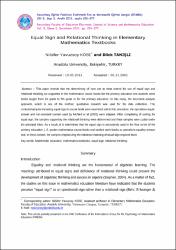| dc.contributor.author | Köse, Nilüfer | |
| dc.contributor.author | Tanışlı, Dilek | |
| dc.date.accessioned | 2019-10-18T19:03:19Z | |
| dc.date.available | 2019-10-18T19:03:19Z | |
| dc.date.issued | 2011 | |
| dc.identifier.issn | 1307-6086 | |
| dc.identifier.uri | http://www.trdizin.gov.tr/publication/paper/detail/TVRNeE9UVXlNZz09 | |
| dc.identifier.uri | https://hdl.handle.net/11421/11040 | |
| dc.description.abstract | Bu araştırma ile, Türkiye’de 1. sınıftan 5. sınıfa kadar okutulan dört seri ilköğretim matematik ders ve öğrenci çalışma kitaplarının eşit işaretinin kullanımını ve ilişkisel düşünmeyi nasıl ve ne derece desteklediğini belirlemek amaçlanmıştır. Araştırmada verilerin toplanmasında nitel araştırma yöntemlerinden doküman incelemesi yaklaşımı kullanılmıştır. Verilerin analizinde ders kitabındaki eşit işaretinin bulunduğu içerikler/örnekler incelenmiş ve bu incelemelerde McNeil ve arkadaşlarının (2006) kullandıkları işlemler-eşitlik-yanıt ve standart olmayan içerik kodlaması esas alınmıştır. Eşit işareti ile ilgili kodlamalar tamamlandıktan sonra her bir ders kitabında ilişkisel düşünmeyi destekleyecek örnekler belirlenmiş, belirlenen bu örnekler ana başlıklar altında kodlanmıştır. Araştırma sonucunda incelenen dört seri ilköğretim 1-5 matematik ders ve öğrenci çalışma kitaplarında eşit işaretinin ağırlıkla işlemler-eşitlik-yanıt biçiminde kullanıldığı ve bu içeriklerde eşit işaretinin ilişkisel anlamını vurgulayıcı örneklerin istenilen düzeyde olmadığı belirlenmiştir. | en_US |
| dc.description.abstract | This paper intends that the determining of how and to what extend the use of equal sign and relational thinking are supported in the mathematics course books for the primary education and students work books taught from 1st grade to 5th grade in for the primary education. In this study, the document analysis approach, which is one of the method, qualitative research was used for the data collection. This contexts/samples including equal sign in course book were examined and in this procedure, the operations-equal-answer and non-standard context used by McNeil et al (2006) were adapted. After completing of coding for equal sign, the samples supporting the relational thinking were determined and these samples were coded under the principal titles. As a result, it is determined that the equal sign is excessively used in the four series of the primary education 1.-5. grades mathematics course books and student work books as operations-equality-answer and, in these context, the samples emphasizing the relational meaning of equal sign required level. | en_US |
| dc.language.iso | eng | en_US |
| dc.rights | info:eu-repo/semantics/openAccess | en_US |
| dc.subject | Eğitim | en_US |
| dc.subject | Bilimsel Disiplinler | en_US |
| dc.subject | Eğitim | en_US |
| dc.subject | Eğitim Araştırmaları | en_US |
| dc.title | Equal sign and relational thinking in elementary mathematics textbooks | en_US |
| dc.title.alternative | İlköğretim matematik ders kitaplarında eşit işareti ve ilişkisel düşünme | en_US |
| dc.type | article | en_US |
| dc.relation.journal | Necatibey Eğitim Fakültesi Elektronik Fen ve Matematik Eğitimi Dergisi | en_US |
| dc.contributor.department | Anadolu Üniversitesi | en_US |
| dc.identifier.volume | 5 | en_US |
| dc.identifier.issue | 2 | en_US |
| dc.identifier.startpage | 251 | en_US |
| dc.identifier.endpage | 277 | en_US |
| dc.relation.publicationcategory | Makale - Ulusal Hakemli Dergi - Kurum Öğretim Elemanı | en_US |
| dc.contributor.institutionauthor | Köse, Nilüfer | |


















